Solar panels are just one way of generating solar power. They are not the most efficient, but they are the most convenient to use on a small to medium scale. Solar cells are made of silicon, and although silicon itself is a very abundant mineral, the manufacturing of solar cells must be carried out in a very clean environment, which leads to high production costs. Photovoltaic cells are made of two types of silicon that, when exposed to solar energy, create a voltage difference between them and, if connected to a circuit, generate an electric current.
Multiple photovoltaic cells will be connected in a module, which can then be installed as needed. The batteries in the module will be connected in series or parallel to produce a specified voltage. For example, a 12-volt solar panel can generate about 16 volts in full sunlight to charge a 12-volt battery.
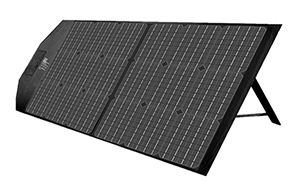
Solar panel working principle
In a pure silicon crystal, atoms form a lattice. These atoms, like other atoms, have a nucleus containing positively charged protons, while around the nucleus are negatively charged electrons in a layer or shell. The electron shell is not full, so neighboring atoms share electrons and hold each other together in the crystal. These electrons are firmly held in place and are not easily moved.
However, pure silicon crystals can be doped with different elements, i.e. add small amounts of impurities. If there are more electrons in the shell of the element used in doping than silicon, there will be negatively charged electrons that can move freely, which is called N-type silicon. The material conducts electricity much better than pure silicon because these spare electrons move around more freely.
However, the crystal is not negatively charged as a whole, because the negative electrons are still balanced by the positive protons in the nucleus. Conversely, if the silicon is doped with elements with fewer electrons in its shell, there will be an overall electron shortage, and the material will be P-type silicon. The tiny regions where electrons are effectively missing are called holes, and these holes can also move freely.
In a solar panel, N-type silicon and P-type silicon touch each other. The electron is attracted to a nearby hole and moves from the N-type to the P-type at the junction. Once this happens at the junction, the region acts as a barrier, preventing further electron movement, and there is an electric field at the junction. If light energy is absorbed by the cell, the energy will push electrons through the junction, and if a circuit is formed between the two silicon types, the electrons will flow through it, back to where they came from, and continue to do so.
The current can do work on the way, charging the battery. This type of cell could be 15-20% efficient, in part because silicon wafers don't absorb all the light energy. A more complex type of battery, called a multijunction battery, may have more pairs of chips above or below, using different doping chemicals, each capable of absorbing a different wavelength of light.
Solar cell types
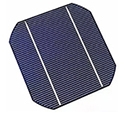 Monocrystalline cell
Monocrystalline cell
Monocrystalline cells are cut from monocrystalline silicon - they are slices of a crystal. From the outside, it has a smooth texture and you can see the thickness of the slices. These are the most efficient and most expensive to produce. They are also rigid and must be installed in a rigid frame to protect them.
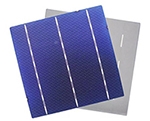 Polycrystalline cell
Polycrystalline cell
A polycrystalline (or polycrystalline) cell is a slice cut from a silicon block and consists of a large number of crystals. They have a speckle reflection appearance. These cells are slightly less efficient and less costly than single-crystal cells and similarly need to be installed in a rigid frame.
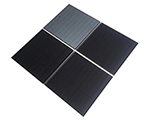 Amorphous cell
Amorphous cell
Amorphous cells are made by placing a thin film of amorphous silicon on a variety of surfaces. They are the least productive and least costly of the three types. Due to the amorphous nature of the thin layer, it is flexible, and if manufactured on a flexible surface, the entire solar panel can be flexible. One characteristic of amorphous solar cells is that their power output decreases over time, especially in the first few months, after which they are stable.
How to mount solar panels?
Direction should it be facing
If you are in the Northern Hemisphere, they should face due south, and if you are in the Southern Hemisphere, they should point due north. If you can't avoid hills or tall trees etc. that block the sun at the end of the day, you may need to change this slightly. If a hill to the west causes you to lose early evening sunlight, then point the panel slightly to the east at your discretion. The early morning sun is low in the sky and therefore of little value.
Angle to the horizontal plane
The Angle of the solar panel relative to the horizontal plane should be the same latitude as in spring and autumn, 15 degrees less in summer and 15 degrees more in winter. If possible, change your panel Angle at least 4 times a year. If you must install them fixed, choose an Angle that is the same as your latitude. Of course, you may want to change this depending on which period of the year your needs are greatest.
Install tracker
If the solar panels were always facing the sun, they would be more efficient at generating electricity. The tracker can be mounted as a panel and pointed at the sun. The passive tracker uses a system where the liquid moves when heated by the sun and is used to move the panel, automatically returning to the correct position in the morning. This type is probably the cheapest, doesn't have too many problems, and can reportedly provide satisfactory results. Active trackers typically use electric servo motors to adjust the Angle of the panel, and these can be controlled by light sensors that sense the position of the sun, or can be controlled by the time the panel is moved to a predetermined position. The increased power generation from using trackers is greater in the summer than in the winter because the sun arcs across the sky more in the summer.
How to wire solar panels?
If your panel is 24 volts, and the solar charge controller and battery are 24 volts, then you need to connect the panel in parallel. Connect all the positive electrodes and separately connect all the negative electrodes.
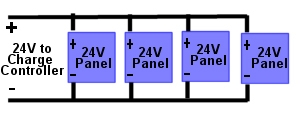
You can connect multiple pairs of panels in series, connecting the positive terminal of one panel to the negative terminal of the next panel to increase voltage. When considering series wiring, the effect of partial masking on the overall efficiency should be considered. Since you don't know how your system will evolve in the future, it's best to buy an even number of panels so that if you want to change the voltage from 24 volts to 24 volts, you can easily pair them in series.
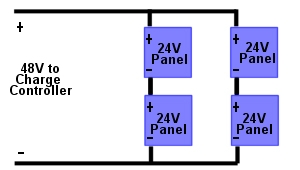
The next issue to consider is the type of wire to be used. We usually think that current can flow freely through the cable, but the cable will have a resistance that tends to limit the current to a small but potentially large degree. This resistance is proportional to the length of the cable (the longer the cable, the greater the resistance) and inversely proportional to the cross-sectional area (the thicker the cable, the smaller the resistance).
Photovoltaic panel grounding
Depending on where you are, you may need to ground the panel frame, which is certainly desirable. An ungrounded frame may generate induced voltage or may accidentally contact a live conductor. Due to the natural oxidation of aluminum, it is not easy to establish a good connection between the copper ground wire and the aluminum frame of the photovoltaic panel, and any instructions from the manufacturer should be followed. In some cases, the DC circuit should also be grounded, and the AC circuit should also be grounded according to the manufacturer's instructions.
Solar panel efficiency
Efficiency is a measure of output divided by some factor. When it comes to the efficiency of a solar panel, we usually focus on the output of a given area. Therefore, a more efficient panel will provide more or less power than a less efficient panel. But that doesn't mean more efficient panels are more economical. More efficient panels may be easier to install, especially if space is limited or a tracking system is being used.
Current solar panels maintain an efficiency of around 40% in converting light into electricity, using multi-junction cells, each of which is tuned to capture light of a different frequency. Silicon is a naturally luminous substance, and the battery is coated with a non-reflective layer to ensure that as much light as possible enters the battery. The cells used in photovoltaic panels for power generation are typically single-junction and have an efficiency of about 15%.
Factors affecting the efficiency of solar panels
- Solar panel construction: Solar panels usually have a layer of glass (protecting the battery) that light must pass through before entering the battery. It can reduce the light reflected by the glass, and it can also capture the light that does not shine on the panel at 90 degrees.
- Effect of temperature: The output of solar panels and solar inverters is affected by their temperature. For every degree Celsius increase in temperature, the power output decreases by 0.25% (amorphous cells) to 0.5% (most crystalline cells). Panel temperatures in warm climates in summer can easily reach 50 °C, resulting in a 12% reduction in output compared to the rated output at 25 °C. If your electricity demand is high in the summer, this efficiency reduction may be important to you.
- Local shadow: Solar panels produce less power when obscured, and ideally should be placed where there will never be any shade. In some cases, this may not be avoidable, so the effect of partial masking should be considered. Not only does the blocked battery produce less power, but since the batteries inside the panel are usually in series, the blocked battery affects the current of the entire panel. If the affected panel is in series with other panels, the output of all of these panels will be affected by the partial shadow of one panel. Therefore, in cases where partial masking cannot be avoided, there may be cases where panels are not connected in series to produce higher voltages that can be used with some inverters.
